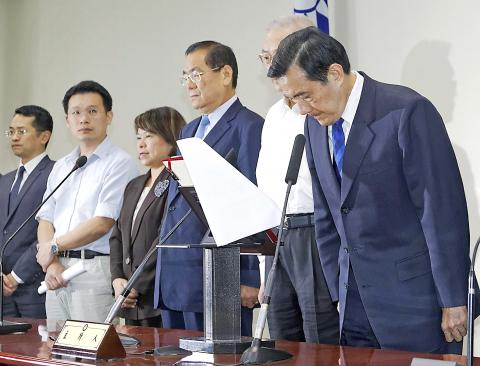More than three-quarters of the public disapproved of President Ma Ying-jeou’s (馬英九) performance almost a month after the nine-in-one elections on Nov. 29, overwhelming his approval rating of 14.2 percent, a survey by Taiwan Brain Trust showed yesterday.
The think tank said that prior to the student-led Sunflower movement in March and April, the president’s disapproval rating stood at 70.9 percent, as opposed to an approval rating of 20.9 percent.
In the latest survey, Ma’s disapproval rating rose further to a record high of 76.2 percent, while his approval rating dipped to a record low, research department director Li Ming-juinn (李明峻) said.

Photo: Reuters
“It is worth mentioning that 57.7 percent of respondents affiliated with the pan-blue camp were dissatisfied with Ma,” Li said at a news conference.
The survey was conducted from Thursday to Saturday last week to gauge whether the elections — which saw the Democratic Progressive Party (DPP) win control of 13 of the nation’s 22 cities and counties, up from six in the previous election, while the Chinese Nationalist Party (KMT) saw its hold drop from 15 to six — reflected changes in the nation’s political landscape.
The survey showed general dissatisfaction with a much-touted Cabinet change: About 58 percent of respondents found the new Cabinet, led by former vice premier Mao Chi-kuo (毛治國) — with just three new appointments — unsatisfactory, against 13.5 percent expressing satisfaction.
Li said that despite Ma stepping down as KMT chairman and former premier Jiang Yi-huah (江宜樺) resigning to “take political responsibility” for the party’s crashing electoral defeat, they failed to stem an increase in public disapproval of the party.
The KMT’s disapproval rating surged to 80 percent from 63.6 percent in June, while its approval rating slid to 11 percent after the elections from 23.6 percent in August.
Contrary to the KMT’s trend, approval ratings for the DPP recorded a continuous increase, from 24.9 percent in June to a record high of 46.2 percent after the elections, while its disapproval rating dropped from 55.6 percent in August to a record low of 35.4 percent in the latest poll.
More than 75 percent of the public agreed on the “high likelihood” that the DPP would regain power in the 2016 presidential election, as it continues to lead the KMT in preferences for political parties, the poll showed.
On a multiple-choice question regarding potential reasons the KMT lost the elections, 87.3 percent cited “below-par governance by the KMT central government,” 36.7 percent blamed it on the KMT candidates themselves and 17.5 percent attributed it to the DPP being a better party.
The survey showed that the DPP has continued to enjoy a higher degree of preference than the KMT since it first overtook the KMT in that rating in October.
Among the four major political parties, 32.7 percent of respondents preferred the DPP, 15.7 percent the KMT, 5.7 percent the People First Party and 3.4 percent the Taiwan Solidarity Union, the survey showed.
The percentage of the public who saw the KMT as the “most-disfavored” political party rose from 34.9 percent in January to 45.8 percent in the latest survey, the think tank said, adding that the DPP was considered most-favored by 32.7 percent, up from 26.8 percent during the same period.

The US government has signed defense cooperation agreements with Japan and the Philippines to boost the deterrence capabilities of countries in the first island chain, a report by the National Security Bureau (NSB) showed. The main countries on the first island chain include the two nations and Taiwan. The bureau is to present the report at a meeting of the legislature’s Foreign Affairs and National Defense Committee tomorrow. The US military has deployed Typhon missile systems to Japan’s Yamaguchi Prefecture and Zambales province in the Philippines during their joint military exercises. It has also installed NMESIS anti-ship systems in Japan’s Okinawa

‘WIN-WIN’: The Philippines, and central and eastern European countries are important potential drone cooperation partners, Minister of Foreign Affairs Lin Chia-lung said Minister of Foreign Affairs Lin Chia-lung (林佳龍) in an interview published yesterday confirmed that there are joint ventures between Taiwan and Poland in the drone industry. Lin made the remark in an exclusive interview with the Chinese-language Liberty Times (the Taipei Times’ sister paper). The government-backed Taiwan Excellence Drone International Business Opportunities Alliance and the Polish Chamber of Unmanned Systems on Wednesday last week signed a memorandum of understanding in Poland to develop a “non-China” supply chain for drones and work together on key technologies. Asked if Taiwan prioritized Poland among central and eastern European countries in drone collaboration, Lin

ON ALERT: Taiwan’s partners would issue warnings if China attempted to use Interpol to target Taiwanese, and the global body has mechanisms to prevent it, an official said China has stationed two to four people specializing in Taiwan affairs at its embassies in several democratic countries to monitor and harass Taiwanese, actions that the host nations would not tolerate, National Security Bureau (NSB) Director-General Tsai Ming-yen (蔡明彥) said yesterday. Tsai made the comments at a meeting of the legislature’s Foreign Affairs and National Defense Committee, which asked him and Minister of National Defense Wellington Koo (顧立雄) to report on potential conflicts in the Taiwan Strait and military preparedness. Democratic Progressive Party (DPP) Legislator Michelle Lin (林楚茵) expressed concern that Beijing has posted personnel from China’s Taiwan Affairs Office to its

BACK TO WORK? Prosecutors said they are considering filing an appeal, while the Hsinchu City Government said it has applied for Ann Kao’s reinstatement as mayor The High Court yesterday found suspended Hsinchu mayor Ann Kao (高虹安) not guilty of embezzling assistant fees, reducing her sentence to six months in prison commutable to a fine from seven years and four months. The verdict acquitted Kao of the corruption charge, but found her guilty of causing a public official to commit document forgery. The High Prosecutors’ Office said it is reviewing the ruling and considering whether to file an appeal. The Taipei District Court in July last year sentenced Kao to seven years and four months in prison, along with a four-year deprivation of civil rights, for contravening the Anti-Corruption